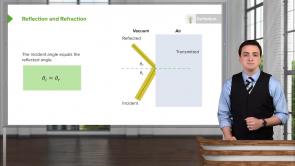The Doppler Effect

Über den Vortrag
Der Vortrag „The Doppler Effect“ von Jared Rovny, PhD ist Bestandteil des Kurses „Sound“.
Quiz zum Vortrag
A source of sound is moving toward you. How would the pitch of its sound compare to when the source is stationary?
- It has a higher pitch (or frequency) when the source is moving toward you.
- It has a higher wavelength when the source is moving toward you.
- It has a lower pitch (or frequency) when the source is moving toward you.
- The wave has a higher speed when the source is moving toward you.
- The pitch (or frequency) is unchanged.
A source of sound is located at position x = 0 and an observer is located at position x = 100 m. How can the observer hear a higher pitch sound from the source?
- Move the source towards higher x or move the observer towards lower x
- Move the source towards lower x or move the observer towards higher x
- Move the source towards higher x or move the observer towards higher x
- Move the source towards lower x or move the observer towards lower x
- Move the source and observer away from each other
Consider the equation for Doppler shifted frequency: fₒ = f_s (v ± vₒ )/(v ± v_s). With assuming v, vₒ, v_s to be the speed of sound, speed of observer and speed of source, respectively (assuming all variables to be non-negative) when is the plus or minus sign used in the numerator and denominator?
- If the direction which the observer is moving is toward the source the plus sign is used in the numerator otherwise the minus sign is used. If the direction which the source is moving is toward the observer the minus sign is used in the denominator otherwise the plus sign is used.
- If the direction which the observer is moving is toward the source the minus sign is used in the numerator otherwise the plus sign is used. If the direction which the source is moving is toward the observer the plus sign is used in the denominator otherwise the minus sign is used.
- If the direction which the observer is moving is toward the source the minus sign is used in the numerator otherwise the plus sign is used. If the direction which the source is moving is toward the observer the minus sign is used in the denominator otherwise the plus sign is used.
- If the direction which the observer is moving is toward the source the plus sign is used in the numerator otherwise the minus sign is used. If the direction which the source is moving is toward the observer the plus sign is used in the denominator otherwise the minus sign is used.
- If the source and observer are moving away from each other the minus sign is used in the numerator and the plus sign in the denominator otherwise the plus sign is used in the numerator and the minus sign in the denominator.
For a stationary source of a sound, how fast must an observer move in order to double the frequency of the sound heard?
- The speed of sound towards the source
- The speed of sound away from the source
- Twice the speed of sound towards the source
- Twice the speed of sound away from the source
- This is never possible
Diese Kurse könnten Sie interessieren
Kundenrezensionen
5,0 von 5 Sternen
| 5 Sterne |
|
1 |
| 4 Sterne |
|
0 |
| 3 Sterne |
|
0 |
| 2 Sterne |
|
0 |
| 1 Stern |
|
0 |
The car animation in this lecture makes this lecture the best by far!







